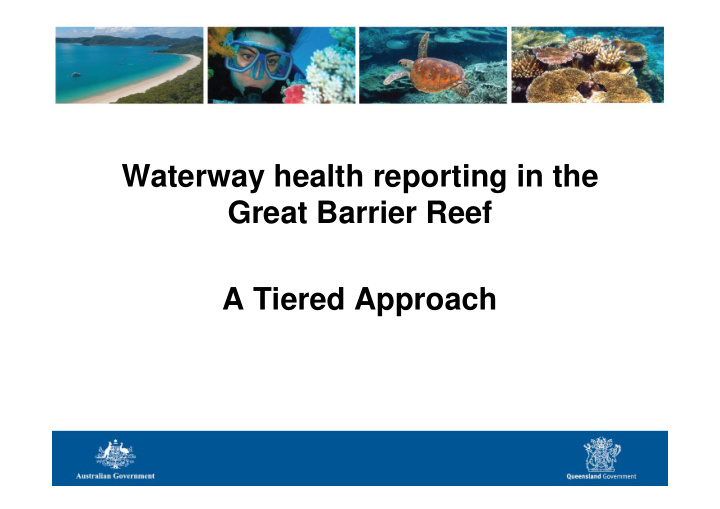



Waterway health reporting in the Great Barrier Reef A Tiered Approach
Great Barrier Reef Outlook Climate Water Coastal Direct change quality development use
Reef 2050 Long-Term Sustainability Plan (Reef 2050 Plan) Ecosystem Economic Communit Water quality* Biodiversity Heritage health benefit y benefits • Reef 2050 Plan water quality Reef Water component = Updated Reef Water Quality Protection Plan. Quality Protection • Better integrate with water quality actions in the Reef 2050 Plan. Plan • Enable new initiatives including Queensland Government responses to the GBR Water Science Taskforce recommendations to be included. • Revise targets incorporating eReefs modelling.
Challenges Spatial scale: • Big catchment = ½ million km 2 • 35 major catchments • Marine area = 350,000 km2 • Highly variable climate • Flood events GBR Catchments cover 424,000 sq km
Great Barrier Reef catchment land use
Partnerships The key decision-making body is the Great Barrier Reef Ministerial Council. A number of committees help ensure a coordinated and cohesive approach to implementation, and appropriate commitment of resources to actions.
• Objective – To measure progress towards the Reef Plan goal and targets. • A collaborative partnership involving the Australian and Queensland Governments, regional groups, researchers and industry. • The integration of monitoring and modelling from the paddock to reef scales. • Strong management–science interaction .
Paddock to Reef Program - overview Catchment Paddock Marine Catchment Measuring Sampling and remote Indicators practices sensing On-farm Water quality Coral monitoring monitoring monitoring Catchment Seagrass monitoring Paddock modelling modelling
Reporting framework
Regional Report Card Partnerships A collaborative approach between industry, community, government and research organisations to report on the health of local waterways and help inform management actions
Partnership Governance • Partnership Chair • Host Organisation • Management Committee • Independent Science review • Partnership staff: technical o communications o secretariat/EO o
Regional Report Conceptual Framework • Conceptual model – pressures, drivers, values • Reporting zones – marine, estuary, freshwater • Program design – indicators, scoring methods, data sources, confidence measures • Methodology – environmental, social, economic, cultural, stewardship • Results – Report Card; website
Example – Gladstone 2016 Report Card Results
Reporting Across Different Scales • Reporting on indicators using different data sets • Reporting broader scale data in both Reef-wide and regional report cards • Availability of data – time lag in reporting – Reef Report Card data availability – Data sets used in regional report cards more than 12 months old – Reader’s context – Community expectations
Scoring Systems – do we compare apples with apples? • Different scoring methodologies between programs • Should we be comparing across scales and across regions?
Other Challenges • Addressing the ‘So what?’ – what value does this reporting provide? • The need for clear and consistent messaging across different reporting and planning processes • Representativeness of data – spatial and temporal limitations • Rules around rolling up of scores can lead to confusing results • Is the there a role for using citizen science data? • Reporting on management practice effectiveness • Filling data gaps – role of the RIMMReP
Successes • Collectively… our reporting tells a more complete picture of waterway health • All report cards informed by rigorous science • Range of quality communication products • Engaged partners with a shared vision for waterway health • Results inform priority regional actions • Continual improvement, learning from each other and working collaboratively
Recommend
More recommend